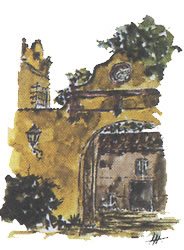Larsen syndrome ... (Larsen syndrome) - Gen FLNB.
Larsen syndrome is a disorder that affects the bone development of the whole organism. Signs and symptoms of Larsen syndrome vary widely even within the same family. These signs and symptoms may include clubfoot, hip dislocations, knees and elbows, small bones extras on wrists and ankles, ends of the fingers square, hypermobility, short stature and kyphosis or scoliosis that can compress the spinal cord, causing weakness in the limbs. Other signs of the disease may include characteristic facial features such as frontal bossing, midface hypoplasia, ocular hypertelorism, cleft palate and hearing loss due to defects in the ear ossicles. In addition, some affected individuals have respiratory problems due to the weakness of the airways that can cause partial closure, apnea and frequent respiratory infections. People with Larsen syndrome may survive to adulthood and intelligence is not affected.
This process is due to mutations in the gene FLNB, located on the short arm of chromosome 3 (3p14.3). This gene encodes the protein filamin B. This protein helps constitute the cytoskeleton which gives structure to the cells and allows them to change shape and move. Filamin B is especially important in skeletal development before birth. This protein is expressed in chondrocytes. Furthermore, the protein appears to be important for normal cell growth and proliferation, differentiation of chondrocytes and cartilage ossification.
They have identified at least 13 mutations in the gene responsible FLNB Larsen syndrome. These mutations change individual amino acids in the protein filamin B or remove a small part of the protein sequence, generating an altered protein. This altered protein appears to have a new atypical function that interferes with the normal proliferation or differentiation of chondrocytes, deteriorating ossification and leading to the signs and symptoms of Larsen syndrome. However, it is not clear why similar mutations in the gene FLNB may result in four different modifications: atelosteogenesis type 1, type 3 atelosteogenesis, Boomerang dysplasia and Larsen syndrome. Certain mutations in exons 2 to 5 of FLNB gene appears to have the most detrimental effects and usually cause severe alterations, such as type 1 atelosteogenesis and Boomerang dysplasia. Type 3 atelosteogenesis Larsen syndrome, that are less intense, are generally milder apparently due to mutations in exons 2 to 5 or mutations in exons 27 to 33. In a few cases, the same mutation has been associated with more than one of these diseases in different people.
This disease is inherited as an autosomal dominant, which means that a copy of the altered gene in each cell is sufficient to express the alteration. In some cases, an affected person inherits the mutation from an affected parent. Other cases are due to new mutations in the gene and occur in people with no history of disease in your family. In a small number of families described Larsen syndrome as an autosomal recessive disease, which means that both copies of the gene in every cell must have mutations for alteration is expressed. The parents of an individual with an autosomal recessive disease have a copy of the mutated gene, but usually show no signs and symptoms of the disease. In some of these cases, autosomal recessive inheritance may actually be the result of several brothers in a family who inherit a single mutated gene from one parent unaffected having a mutation FLNB only some or all of their reproductive cells. When a mutation is present only in reproductive cells, known as germline mosaicism.
Tests in IVAMI: in IVAMI perform detection of mutations associated with Larsen syndrome, by complete PCR amplification of exons FLNB gene, and subsequent sequencing.
Samples recommended: EDTA blood collected for separation of blood leukocytes, or impregnated sample card with dried blood (IVAMI may mail the card to deposit the blood sample).



